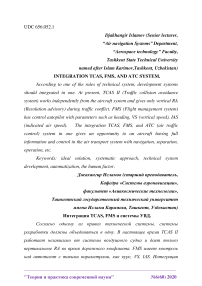Integration TCAS, FMS, and ATC system
Автор: Islamov D.
Журнал: Теория и практика современной науки @modern-j
Рубрика: Математика, информатика и инженерия
Статья в выпуске: 6 (60), 2020 года.
Бесплатный доступ
According to one of the rules of technical system, development systems should integrated in one. At present, TCAS II (Traffic collision avoidance system) works independently from the aircraft system and gives only vertical RA (Resolution advisory) during traffic conflict. FMS (Flight management system) has control autopilot with parameters such as heading, VS (vertical speed), IAS (indicated air speed). The integration TCAS, FMS, and ATC (air traffic control) system in one gives an opportunity to an aircraft having full information and control in the air transport system with navigation, separation, operation, etc.
Ideal solution, systematic approach, technical system development, automatization, the human factor
Короткий адрес: https://sciup.org/140275615
IDR: 140275615 | УДК: 656.052.1
Текст научной статьи Integration TCAS, FMS, and ATC system
In an example, we can consider TCAS development, in the future according to with ideality any system disappears but function will exist. How it can happen, TCAS will join with other aircraft systems, for example with FMS (Flight Management System), the role of TCAS could be performed by FMS with autopilot operation. It could give us several benefits: autopilot operation will be coordinated with FMS and other nearby flying aircraft systems, the prevention from human factor negative influence, etc. The same time integration ATC system to aircraft FMS gives a lot opportunity in questions such as navigation, coordination, separation, flight safety, effective use of airspace, etc. The technology of ADS-B is applicable in this situation. As result, there is no necessity of further developing TCAS III or TCAS IV.
Examples of air accidents which could be prevented if integration above systems applied:
-
a) A mid-air collision between a Tupolev TU154M, which was on a flight from Moscow/ Russia to Barcelona/ Spain, and a Boeing B757-200, on a flight from Bergamo/Italy to Brussels/ Belgium, occurred north of the city of Ueberlingen (Lake of Constance). Both aircraft flew according to IFR (Instrument Flight Rules) and were under control of ACC Zurich. After the collision both aircraft crashed into an area north of Ueberlingen. There were a total of 71 people on board of the two airplanes, none of which survived the crash.
The following immediate causes have been identified:
-
• The imminent separation infringement was not noticed by ATC in time. The instruction for the TU154M to descend was given at a time when the prescribed separation to the B757-200 could not be ensured anymore.
-
• The TU154M crew followed the ATC instruction to descend and continued to do so even after TCAS advised them to climb. This maneuver was performed contrary to the generated TCAS RA.
The following systemic causes have been identified:
-
• The integration of ACAS/TCAS II into the system aviation was insufficient and did not correspond in all points with the system philosophy. The regulations concerning ACAS/TCAS published by ICAO and as a result the regulations of national aviation authorities, operations and procedural instructions of the TCAS manufacturer and the operators were not standardized, incomplete and partially contradictory.
-
• Management and quality assurance of the air navigation service company did not ensure that during the night all open workstations were continuously staffed by controllers.
-
• Management and quality assurance of the air navigation service company tolerated for years that during times of low traffic flow at night only one controller worked and the other one retired to rest.
-
b) The regular air transport airplane was a Boeing 737-8EH, manufactured in the United States and registered in Brazil as PR-GTD, operated by the Brazilian airline company “Gol Transportes Aéreos S.A.”. The executive airplane, an Embraer-135 BJ Legacy, manufactured in Brazil and registered in the United States as N600XL, was operated by the American company “ExcelAire Services, Inc.” The PR-GTD airplane was operating the regular flight GLO1907, from Manaus (Amazonas State) to the city of Rio de Janeiro (Rio de Janeiro State), with a technical stop programmed for Brasilia International Airport/ President Juscelino Kubitschek, in the Federal District, under the rules of RBHA 121. Orizontal stabilizer of Excel Air Services E145
Operation of the Transponder and radio/navigation equipment of the N600XL airplane;
The degree of knowledge and preparedness of the N600XL pilots for the conduction of the flight in Brazil;
Aspects relative to the rules and procedures of the Air Traffic Control Systems currently in operation, both in Brazil and worldwide; and
The Communication and Surveillance Systems of the Brazilian Airspace Control System (SISCEAB).
In the description of the Operational Aspect of the Human Factor, the aspects related to the pilots and the airplane are approached, corresponding to the first two focal points. The aspects relative to the Brazilian Air Traffic Control organization, regarding the regulation, operation and infrastructure, which correspond to the last two focal points, are approached in the Psychological Aspect of the Human Factor.
In conclusion, we can say integration systems and automatization making human as observer can prevent as from many accidents in future. This is the requirements from modern technology.
Список литературы Integration TCAS, FMS, and ATC system
- TRIZ Journal, www.TRIZ-journal.com
- Bundesstelle für Flugunfalluntersuchung German Federal Bureau of Aircraft Accidents Investigation. Investigation Report: AX001-1-2/02 May 2004.
- Aeronautical accident investigation and prevention center. Final report: A-00X/CENIPA/2008.


